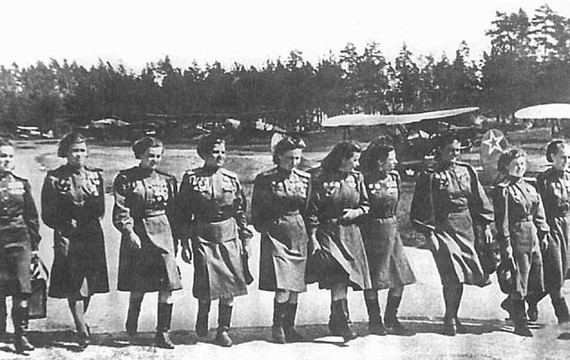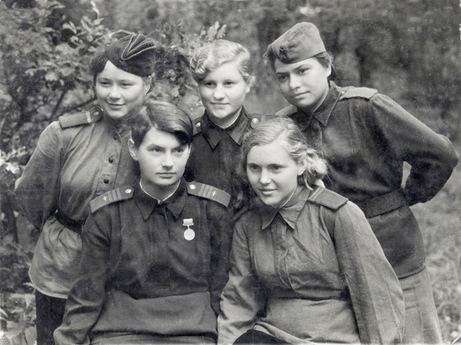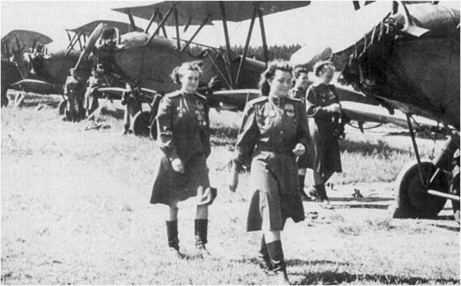Active 1942–1945 Role Tactical bombing Regimental Commander Yevdokia Bershanskaya Branch Soviet Air Forces | Country Soviet Union Nickname(s) Night Witches Bomber Polikarpov Po-2 Engagement Eastern Front | |
 | ||
Engagements Eastern Front (World War II) Similar Soviet Air Forces, Women's Army Corps, Soviet Army, Soviet Armed Forces, Red Army | ||
Sabaton night witches official lyric video
"Night Witches" is the English translation of Nachthexen, a World War II German nickname (Russian Ночные ведьмы, Nochnye Vedmy) for the women military aviators of the 588th Night Bomber Regiment, known later as the 46th "Taman" Guards Night Bomber Aviation Regiment, of the Soviet Air Forces. Though women were initially barred from combat, Soviet Premier Joseph Stalin issued an order on October 8, 1941 to deploy three women's air force units, including the 588th regiment. The regiment, formed by Colonel Marina Raskova and led by Major Yevdokia Bershanskaya, was made up entirely of women volunteers in their late teens and early twenties.
Contents
- Sabaton night witches official lyric video
- People
- Exclusively female units
- Film and television depictions
- References

The regiment flew harassment bombing and precision bombing missions against the German military from 1942 until the end of the war. At its largest, it had 40 two-person crews. The regiment flew over 24,000 missions and dropped 23,000 tons of bombs. It was the most highly decorated all-women unit in the Soviet Air Force, each pilot having flown over 800 missions by the end of the war and twenty-three having been awarded the Hero of the Soviet Union title. Thirty of its members died in combat.

The regiment flew in wood-and-canvas Polikarpov Po-2 biplanes, a 1928 design intended for use as training aircraft and for crop dusting, and to this day the most-produced biplane in aviation history. The planes could carry only six bombs at a time, so 8 or more missions per night were often necessary. Although the aircraft were obsolete and slow, the pilots made daring use of their exceptional maneuverability; they had the advantage of having a maximum speed that was lower than the stall speed of both the Messerschmitt Bf 109 and the Focke-Wulf Fw 190, and as a result, German pilots found them very difficult to shoot down. An attack technique of the night bombers was to idle the engine near the target and glide to the bomb release point, with only wind noise left to reveal their location. German soldiers likened the sound to broomsticks and named the pilots "Night Witches." Due to the weight of the bombs and the low altitude of flight, the pilots carried no parachutes.

From June 1942, the 588th Night Bomber Regiment was within the 4th Air Army. In February 1943, the regiment was honored with a reorganization into the 46th Guards Night Bomber Aviation Regiment and in October 1943 it became the 46th "Taman" Guards Night Bomber Aviation Regiment. "Taman" referred to the unit's involvement in two celebrated Soviet victories on the Taman Peninsula during 1943.

People

Exclusively female units

On October 8, 1941, Order number 0099 specified the creation of three women's squadrons—all personnel from technicians to pilots would be entirely composed by women. These were:
Although all three regiments had been planned to have women exclusively, only the 588th would remain an all-women regiment throughout the war. The 586th Regiment had to employ male mechanics as no women had received training to work on the Yakovlev fighter planes before the war. The 586th's woman commander, Major Tamara Aleksandrovna Kazarinova, was replaced by a man, Major Aleksandr Vasilievich Gridnev, in October 1942. The 587th Regiment was originally under the command of Marina Raskova, but after her death in 1942, a male commanding officer, Major Valentin Vasilievich Markov, replaced her. The 587th's Petlyakov Pe-2 dive bombers also required a tall person to operate the top rear machine gun, but not enough women recruited were tall enough, requiring some men to join the aircrews as radio operator/tail gunner.
Film and television depictions
In 1981, a Soviet feature-length film called Night Witches In The Sky (В небе ночные ведьмы) was directed by Evgenia Zhigulenko (Евгения Жигуленко), Hero of the Soviet Union, and one of the members of the 588th.
In 2001, a UK-Russian co-production starring Malcolm McDowell, Sophie Marceau and Anna Friel was due to be made, but failed to get backing from an American studio.
In 2013, a short animation called The Night Witch commemorating Nadezhda Popova, who had died earlier that year, was commissioned in collaboration with The New York Times Magazine's The Lives They Lived issue and directed by Alison Klayman.
There was a film project underway in 2013, to be written by Gregory Allen Howard and financed by the grandson of Boris Yeltsin.
In 2013, a Russian TV series titled Night Swallows was produced and distributed.
